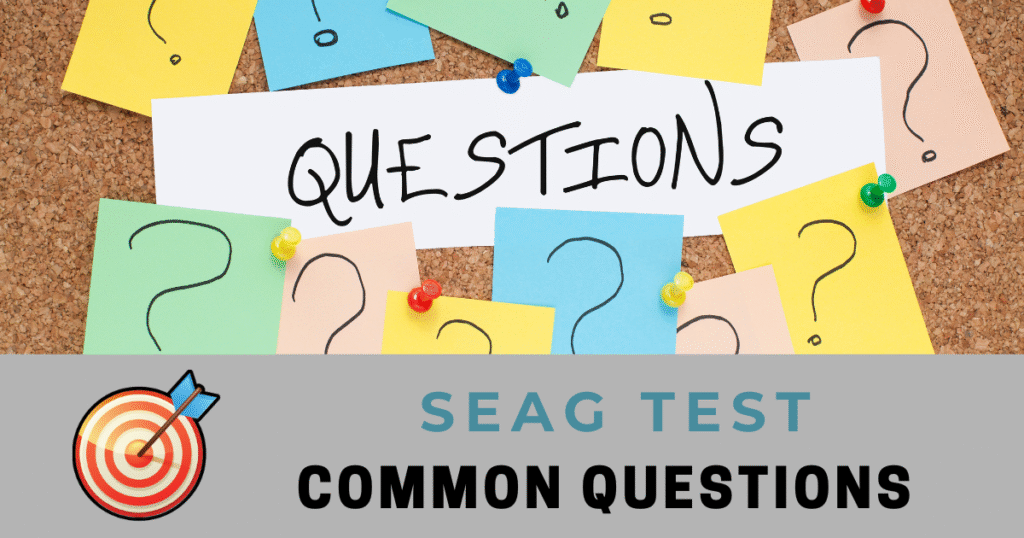Common Questions about the SEAG test
Your Most Common SEAG Transfer Test Questions – Answered!

If your child is preparing for the SEAG Transfer Test in Northern Ireland, you likely have a lot of questions. We’ve gathered the most common questions about the SEAG test from parents—along with clear answers to help you feel confident and informed.
📌 Want practice materials and book lists? Head over to ontargetresources.co.uk — trusted by teachers and parents across NI.
1. What is the SEAG Test?
The SEAG (Schools’ Entrance Assessment Group) test is used by 62 grammar schools in Northern Ireland to help decide Year 8 admissions.
It replaces the older AQE and GL (PPTC) exams, offering a single, unified entrance assessment.
2. What’s the Format of the SEAG Test?
The SEAG assessment has two key parts:
📝 English (or Gaeilge) – covers spelling, punctuation, grammar, and comprehension.
➕ Maths – includes both multiple-choice and free response questions, assessing number work, problem-solving, and reasoning.
Each section contains a mix of question styles and is designed to reflect the Key Stage 2 curriculum.
3. How Is It Scored?
SEAG uses a Transfer Score and Band system. Your child will receive:
- A standardised score (TSAS)
- A banding outcome (Band 1–5)
- A percentile rank showing their performance within the full cohort
🎯 Achieving a higher Transfer Score and Band 1 or 2 is considered a strong result for selective schools.
4. Who Can Sit the SEAG Test?
Children born between 2 July 2013 and 1 July 2014 are normally eligible for the 2024–25 academic year.
Pupils outside this age range may still be considered if their primary school principal supports the application.
5. How Do I Register for the SEAG Test?
To enter your child into the SEAG Transfer Test 2025, follow these steps:
- Registration opens on Monday 19 May 2025
- Closes at 11:59 pm on Friday 19 September 2025
🛠️ Submit via the official SEAG portal before the deadline. https://seagni.co.uk/
💷 Application Fee
- Standard fee: £20.00
- Free for children receiving Free School Meals (FSME)—proof of entitlement must be uploaded
🧾 Documents You’ll Need
- Child’s full name, address, DOB, and primary school name
- Passport-sized photo
6. Which Schools Use the SEAG Test?
All 62 grammar schools across Northern Ireland that use academic selection now participate in SEAG.
Each school may have its own admissions criteria, so always check their individual websites for details.
7. How Do I Prepare My Child for the SEAG Test?
📆 Start in P6 and build steadily into early P7.
Key areas to focus on include:
- Strong reading habits (see On Target’s recommended book list for the SEAG GL Transfer Test)
- English skills (spelling, punctuation, comprehension)
- Maths fluency and problem-solving
- Timed practice papers and mock tests
🧠 Tip: Mix in fiction and non-fiction reading to support comprehension!
8. What Happens on Test Day?
Pupils will have access to a Familiarisation Day so they can get used to the test setting.
On the day, your child should bring their:
- Admission Card (Pupil Card) – downloaded from the SEAG portal
- Nothing else is required – pencils, rubbers, and rough work paper are provided by the test centre
- Water is also provided
- Pupils may bring a highlighter, but it must not be used on the answer sheet
- Rough work can be done on the question paper, not the answer sheet
⏱️ Invigilators will give time updates throughout the exam, and clocks will be clearly visible.
💡 Want More Help?
Whether you’re looking for:
- Practice materials
- Reading lists
- Comprehension books
- Transfer tips from experienced teachers
📘 Visit OnTargetResources.co.uk — created by NI teachers, trusted by hundreds of parents.
